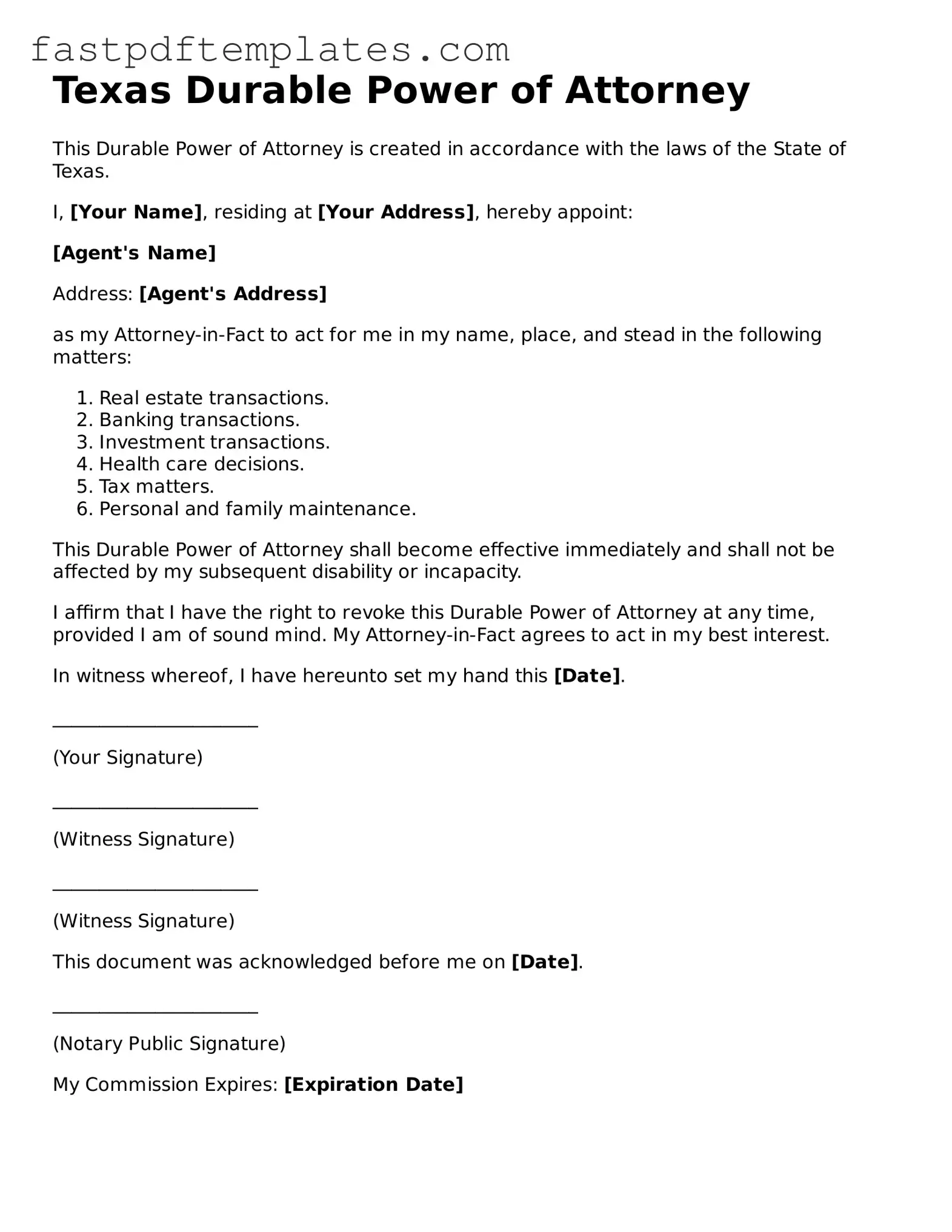The Texas Durable Power of Attorney form shares similarities with the General Power of Attorney. Both documents grant an individual the authority to act on behalf of another person in various matters, such as financial transactions or legal decisions. However, the General Power of Attorney becomes ineffective if the principal becomes incapacitated, while the Durable Power of Attorney remains in effect despite such circumstances. This distinction allows for continued management of affairs when the principal is unable to make decisions for themselves.
Another document akin to the Texas Durable Power of Attorney is the Medical Power of Attorney. This form specifically empowers an agent to make healthcare decisions on behalf of the principal when they are unable to do so. While the Durable Power of Attorney focuses on financial and legal matters, the Medical Power of Attorney is strictly concerned with medical care and treatment options. Both forms require the principal to designate an agent, ensuring that their preferences are honored even in times of incapacity.
The Living Will is also comparable to the Texas Durable Power of Attorney, particularly in the context of healthcare decisions. A Living Will outlines an individual’s wishes regarding medical treatment in situations where they cannot communicate their preferences. While the Durable Power of Attorney allows an agent to make decisions, the Living Will serves as a guide for those decisions, providing clarity about the principal’s desires concerning life-sustaining treatments.
The Revocable Trust shares some characteristics with the Texas Durable Power of Attorney, particularly regarding asset management. Both documents allow for the management of a person’s financial affairs, but a Revocable Trust can also facilitate the distribution of assets upon the principal’s death. Unlike the Durable Power of Attorney, which ceases upon the principal’s death, a Revocable Trust continues to operate, providing a seamless transition of asset management and inheritance.
A Healthcare Proxy is similar to the Texas Durable Power of Attorney in that it designates someone to make medical decisions on behalf of another. This document is specifically focused on healthcare choices, while the Durable Power of Attorney encompasses a broader range of responsibilities. Both documents emphasize the importance of appointing a trusted individual to act in the best interests of the principal, ensuring that their values and preferences are respected.
The Financial Power of Attorney is closely related to the Texas Durable Power of Attorney, as both grant authority to manage financial matters. However, the Financial Power of Attorney may not necessarily be durable, meaning it could become invalid if the principal becomes incapacitated. In contrast, the Texas Durable Power of Attorney remains effective under such circumstances, allowing the designated agent to continue managing financial affairs without interruption.
The Authorization for Release of Medical Records is another document that aligns with the Texas Durable Power of Attorney, specifically regarding healthcare decisions. This form allows an individual to grant permission for their medical information to be shared with designated parties. While the Durable Power of Attorney enables an agent to make decisions about treatment, the Authorization for Release of Medical Records ensures that the agent has access to necessary medical information to make informed choices.
The Guardianship Application can also be viewed as similar to the Texas Durable Power of Attorney, especially in cases where an individual may need assistance in managing their affairs. A guardianship is a legal relationship established by a court, allowing a guardian to make decisions for someone deemed incapacitated. While the Durable Power of Attorney is a proactive measure that individuals can set up themselves, guardianship is often a reactive solution that requires court intervention.
Lastly, the Advance Directive is akin to the Texas Durable Power of Attorney, particularly in its role in healthcare decisions. An Advance Directive encompasses both a Living Will and a Medical Power of Attorney, providing comprehensive guidance on an individual’s healthcare preferences. While the Durable Power of Attorney focuses on financial matters, the Advance Directive ensures that the principal’s medical wishes are clearly articulated and respected during times of incapacity.
